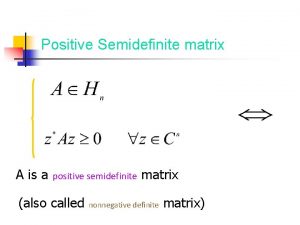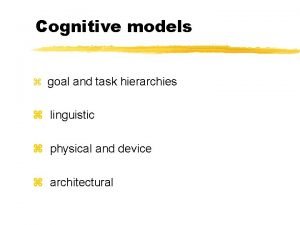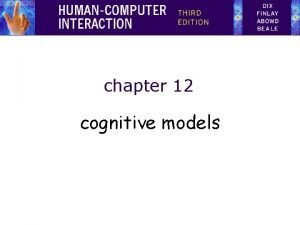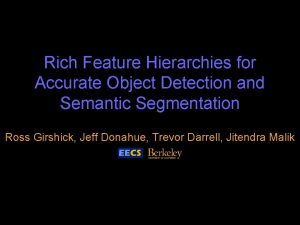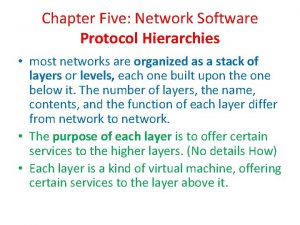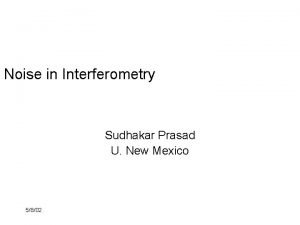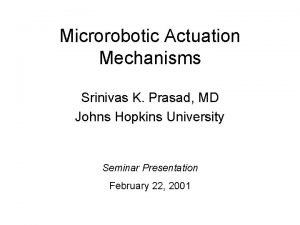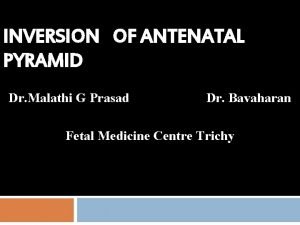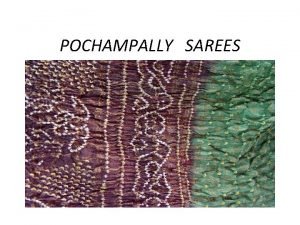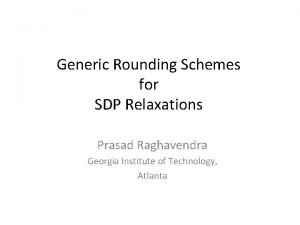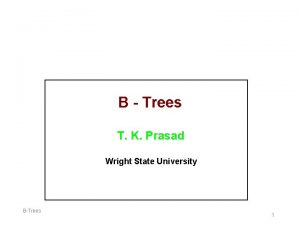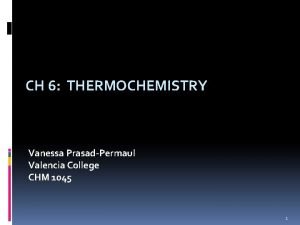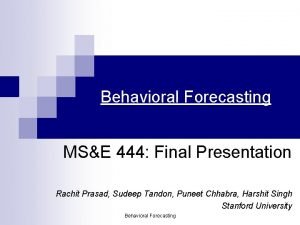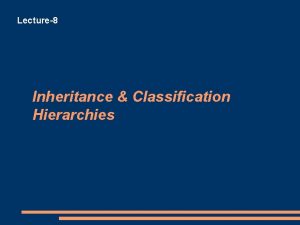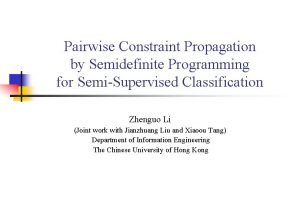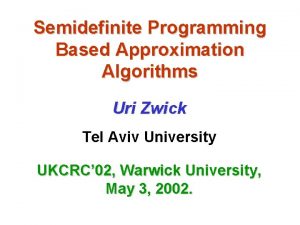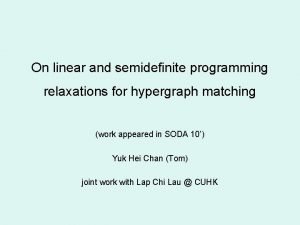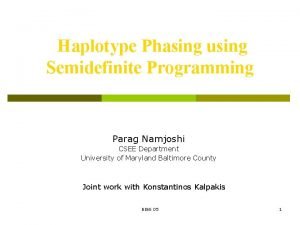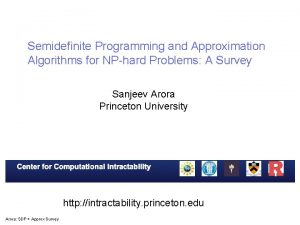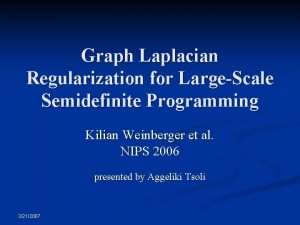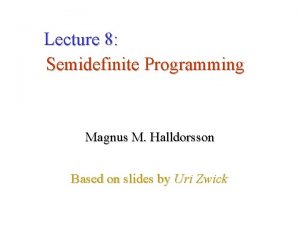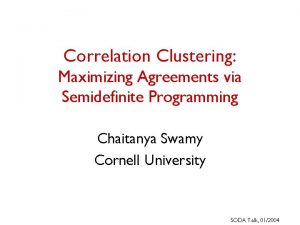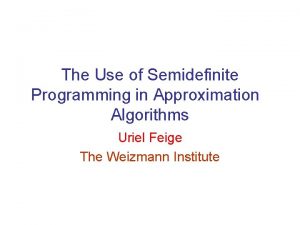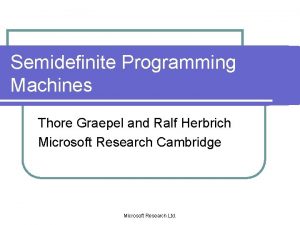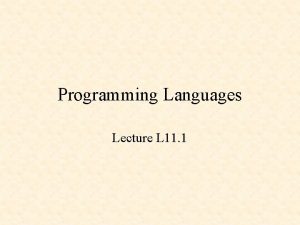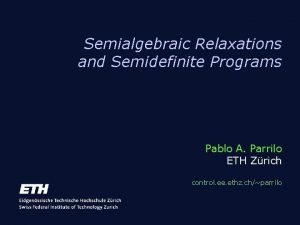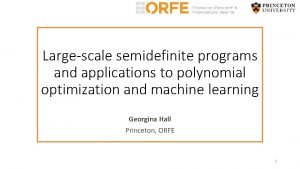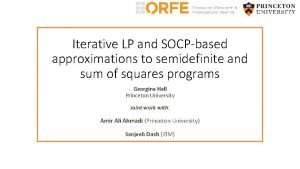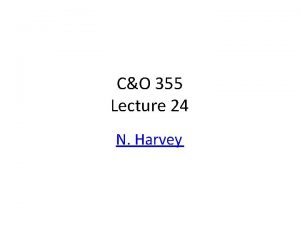On the Power of Semidefinite Programming Hierarchies Prasad




![Motivation Unique Games Conjecture (UGC) Distinguish: YES: NO: [Khot’ 02] Motivation Unique Games Conjecture (UGC) Distinguish: YES: NO: [Khot’ 02]](https://slidetodoc.com/presentation_image_h2/dfe07ece3224ad8ed2d3cbfac6aa5a4f/image-5.jpg)
















![Subexponential Algorithm for Unique Games [Arora-Barak-S. ’ 10, Barak-Raghavendra-S. ’ 11] Contrast many NP-hard Subexponential Algorithm for Unique Games [Arora-Barak-S. ’ 10, Barak-Raghavendra-S. ’ 11] Contrast many NP-hard](https://slidetodoc.com/presentation_image_h2/dfe07ece3224ad8ed2d3cbfac6aa5a4f/image-22.jpg)















- Slides: 37

On the Power of Semidefinite Programming Hierarchies Prasad Raghavendra David Steurer Georgia Institute of Technology, Atlanta, GA. Microsoft Research New England Cambridge, MA

Overview • Background and Motivation • Introduction to SDP Hierarchies (Lasserre SDP hierarchy) • Rounding SDP hierarchies via Global Correlation. BREAK • Graph Spectrum and Small-Set Expansion. • Sum of Squares Proofs.

Background and Motivation

Max-Cut Problem Input: A graph G Find: A cut with maximum number of crossing edges Semidefinite Program for Max. Cut: [Goemans-Williamson 94] Embed the graph on the N - dimensional unit ball, Maximizing v 2 v 1 ¼ (Average Squared Length of the edges) v 3 [Khot-Kindler-Mossel-O’Donnell] Pick a random hyperplane, and output the cut it induces! Under the Unique Games Conjecture, -- a 0. 878 approximation Goemans-Williamson SDP yields the optimal approximation v 5 ratio for Max. Cut. v 4
![Motivation Unique Games Conjecture UGC Distinguish YES NO Khot 02 Motivation Unique Games Conjecture (UGC) Distinguish: YES: NO: [Khot’ 02]](https://slidetodoc.com/presentation_image_h2/dfe07ece3224ad8ed2d3cbfac6aa5a4f/image-5.jpg)
Motivation Unique Games Conjecture (UGC) Distinguish: YES: NO: [Khot’ 02]

Assuming the Unique Games Conjecture, A simple semidefinite program (Basic-SDP) yields the optimal approximation ratio for Constraint Satisfaction Problems [Raghavendra`08][Austrin-Mossel] MAX CUT [Khot-Kindler-Mossel-ODonnell][Odonnell-Wu] MAX 2 SAT [Austrin 07][Austrin 08] Metric Labeling Problems [Manokaran-Naor-Raghavendra-Schwartz`08] MULTIWAY CUT, 0 -EXTENSION Ordering CSPs [Charikar-Guruswami-Manokaran-Raghavendra-Hastad`08] MAX ACYCLIC SUBGRAPH, BETWEENESS Is the conjecture true? Strict Monotone CSPs [Kumar-Manokaran-Tulsiani-Vishnoi`10] Many many ways to disprove the conjecture! VERTEX [Khot-Regev], HYPERGRAPH VERTEX COVER Find. Ca. OVER better algorithm for any one of these problems. Kernel Clustering Problems [Khot-Naor`08, 10] Grothendieck Problems [Khot-Naor, Raghavendra-Steurer]

Question I: Could some small LINEAR PROGRAM give a better approximation for Max. Cut or Vertex Cover thereby disproving the UGC? Probably Not! Question II: [Charikar-Makarychev][Schoenebeck-Tulsiani] Could somefor small SEMI DEFINITE ROGRAM For Max. Cut, several classes of linear. Pprograms, give a better approximation for Max. Cut or Vertex Cover exponential sized linearthe programs thereby disproving UGC? are necessary to even beat the trivial ½ approximation! We don’t know.

Max Cut SDP: Embedd the graph on the N - dimensional unit ball, The Simplest Relaxation for Max. Cut v 2 v 1 v 3 Maximizing ¼ (Average squared length v 5 of the edges) v 4 In the integral solution, all the vectors vi are 1, -1. Thus they satisfy additional constraints For example : (vi – vj)2 + (vj – vk)2 ≥ (vi – vk)2 (the triangle inequality) Does adding triangle inequalities improve approximation ratio? (and thereby disprove UGC!)


Until 2009: Adding a simple constraint on every 5 vectors could yield a better approximation for Max. Cut, and disproves UGC! Building on the work of [Khot-Vishnoi],

Why play this game? Connections between SDP hierarchies, Spectral Graph Theory and Graph Expansion. New algorithms based on SDP hierarchies. [Raghavendra-Tan] Improved approximation for Max. Bisection using SDP hierarchies [Barak-Raghavendra-Steurer] Algorithms for 2 -CSPs on low-rank graphs. New Gadgets for Hardness Reductions: [Barak-Gopalan-Hastad-Meka-Raghavendra-Steurer] A more efficient long code gadget. Deeper understanding of the UGC – why it should be true if it is.

Introduction to SDP Hierarchies (Lasserre SDP hierarchy)

Revisiting Max. Cut Semidefinite Program 1 -1 Good News: Convex program that exactly captures the Max. Cut problem.

Using Moments

Constraints on Moments

Constraints on Moments

Degree d = 2 (Goemans-Williamson SDP)

``Matrix M is positivesemidefinite’

Positive Semidefiniteness (where are the vectors? ) For degree d-Lasserre SDP, the moments are appropriately arranged to give a p. s. d. matrix.

Cheat Sheet: d-round Lasserre SDP -1 -1 1 15 1 1 3 10 1 1 -1 -1 1 7 -1 X 2 X 3 X 4 ……………. . X 15 …………………. 1 -1 ……………. . 1 1 1 - 1 -1 -1 -1 ……………. . 1 1 1 -1 -1 -1 ……………. . 1 1 1 - 1 -1 ……………. . 1 1 1 -1 1 ………………………………… 1 1 1 -1 ……………. . 1 1 1 -1 1 1 - 1 Fictitious Distribution over assignments

Rounding SDP Hierarchies
![Subexponential Algorithm for Unique Games AroraBarakS 10 BarakRaghavendraS 11 Contrast many NPhard Subexponential Algorithm for Unique Games [Arora-Barak-S. ’ 10, Barak-Raghavendra-S. ’ 11] Contrast many NP-hard](https://slidetodoc.com/presentation_image_h2/dfe07ece3224ad8ed2d3cbfac6aa5a4f/image-22.jpg)
Subexponential Algorithm for Unique Games [Arora-Barak-S. ’ 10, Barak-Raghavendra-S. ’ 11] Contrast many NP-hard approximation problems require exponential time (assuming 3 -SAT does) […, Moshkovitz-Raz] often these lower bounds are known unconditionally for SDP hierarchies [Schoenebeck, Tulsiani] separation of UG from known NP-hard approximation problems

Subexponential Algorithm for Unique Games General framework for rounding SDP hierarchies (not restricted to Unique Games) [Barak-Raghavendra-S. ’ 11, Guruswami-Sinop’ 11] Potentially applies to wide range of “graph problems” Examples: MAX CUT, SPARSEST CUT, COLORING, MAX 2 -CSP Some more successes (polynomial time algorithms) Approximation scheme for general MAX 2 -CSP [Barak-Raghavendra-S. ’ 11] Better 3 -COLORING approximation for some graph families Better approximation for MAX BISECTION (general graphs) [Arora-Ge’ 11] [Raghavendra-Tan’ 12] [Austrin-Benabbas-Georgiou’ 12]

Subexponential Algorithm for Unique Games General framework for rounding SDP hierarchies (not restricted to Unique Games) [Barak-Raghavendra-S. ’ 11, Guruswami-Sinop’ 11] Potentially applies to wide range of “graph problems” Examples: MAX CUT, SPARSEST CUT, COLORING, MAX 2 -CSP Key concept: global correlation

Interlude: Pairwise Correlation Examples: entropy lost due to conditioning

Sampling Rounding problem Given UG instance Sample similar (? ) More convenient to think about actual distributions instead of SDP solutions But: proof should only “use” linear equalities satisfied by these moments and certain linear inequalities, namely non-negativity of squares (Can formalize this restriction as proof system next talk)

Sampling by conditioning Hope: need to condition only a small number of times; then do something else How can conditioning help?

How can conditioning help? Allows us to assume: distribution has low global correlation typical pair of variables almost pairwise independent Claim: general cases reduces to case of low global correlation Proof: Idea: significant global correlation conditioning decreases entropy

How can conditioning help? Allows us to assume: distribution has low global correlation typical pair of variables almost pairwise independent How can low global correlation help?

How can low global correlation help? For some problems, this condition alone gives improvement over BASIC SDP Example: MAX BISECTION [Raghavendra-Tan’ 12, Austrin-Benabbas-Georgiou’ 12] hyperplane rounding gives near-bisection if global correlation is low

How can low global correlation help? For Unique Games Extreme cases with low global correlation 1) no entropy: all variables are fixed 2) many small independent components: . . .

How can low global correlation help? For Unique Games Only Extreme cases with low global correlation 1) no entropy: all variables are fixed 2) many small independent components: . . . Show: no other cases are possible! (informal)

How lowcomponents global correlation help? & recurse on them Idea: can round independently How many. Games edges ignored in total? (between different components) For Unique Only Extreme cases with low global correlation 1) no entropy: all variables are fixed easy to “sample” 2) many small independent components: . . .

How can low global correlation help? For Unique Games Only Extreme cases with low global correlation 1) no entropy: all variables are fixed 2) many small independent components: . . .

Suppose: Then: (in constraint graph, S has low expansion) Proof: Correlation Propagation proof uses non-negativity of squares (sum-of-squares proof) works also for SDP hierarchy

Suppose: Then: (in constraint graph, S has low expansion) Proof: Correlation Propagation low global correlation

Suppose: Then: Proof: (local: typical edge) (global: typical pair) o(n) Thanks! (closely related to UGC)
 Sigular matrix
Sigular matrix Issues for goal hierarchies
Issues for goal hierarchies Issues for goal hierarchies
Issues for goal hierarchies Rich feature hierarchies for accurate object detection
Rich feature hierarchies for accurate object detection Context dependent memory ap psychology
Context dependent memory ap psychology Network software protocol hierarchies
Network software protocol hierarchies Preying mantra wangechi mutu
Preying mantra wangechi mutu Protocol hierarchies
Protocol hierarchies Draw the power triangle
Draw the power triangle Perbedaan linear programming dan integer programming
Perbedaan linear programming dan integer programming Greedy vs dynamic programming
Greedy vs dynamic programming What is system programming
What is system programming Linear vs integer programming
Linear vs integer programming Perbedaan linear programming dan integer programming
Perbedaan linear programming dan integer programming Dr annie prasad
Dr annie prasad Sudhakar prasad
Sudhakar prasad Srinivas prasad md
Srinivas prasad md Edamana prasad
Edamana prasad Dr prasad gourineni
Dr prasad gourineni Drbavaharan13
Drbavaharan13 Vanessa prasad
Vanessa prasad Write all the steps from thread to saree in brief class 4
Write all the steps from thread to saree in brief class 4 Bharat penmecha
Bharat penmecha Prasad raghavendra
Prasad raghavendra Lawrence prasad
Lawrence prasad Viji prasad
Viji prasad Tk wright
Tk wright The gita project
The gita project Shiva prasad kasiviswanathan
Shiva prasad kasiviswanathan Gaura devi
Gaura devi Spread of chipko movement
Spread of chipko movement Astha prasad
Astha prasad Prasad calyam
Prasad calyam Vanessa prasad permaul
Vanessa prasad permaul Vanessa prasad permaul
Vanessa prasad permaul Rachit prasad
Rachit prasad Bill prasad
Bill prasad Amita prasad ias
Amita prasad ias
